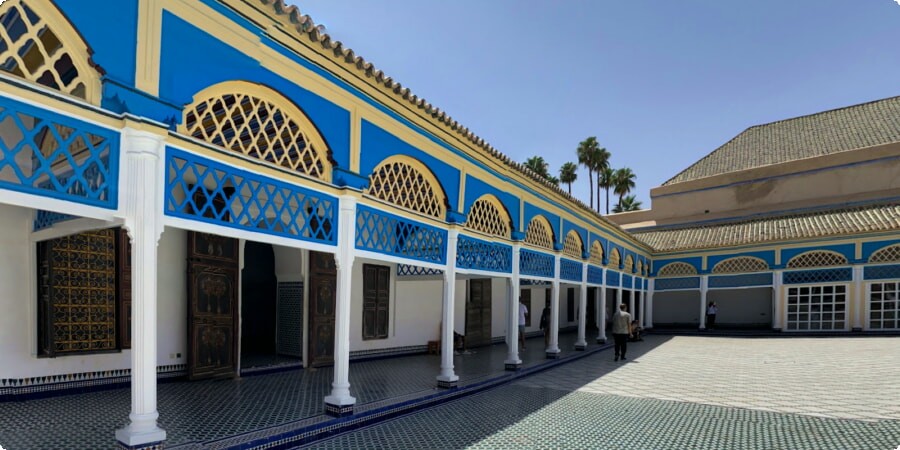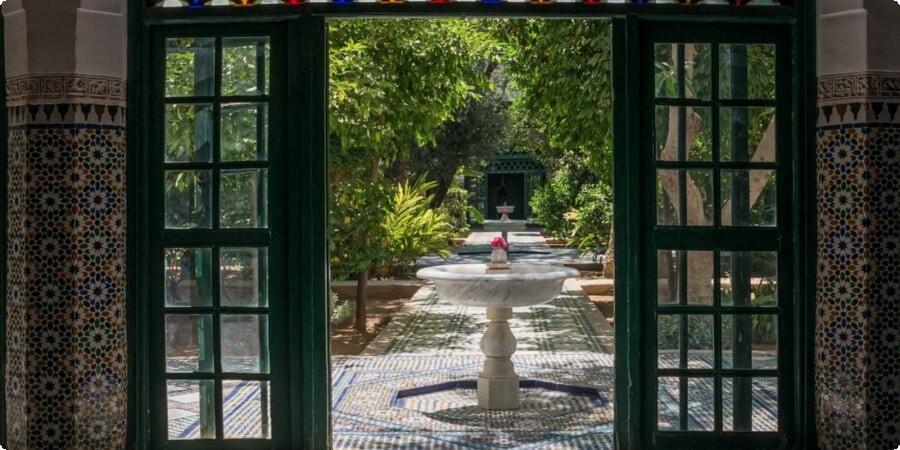Bahia Palace: A Glimpse into Moroccan Artistry and Design
Nestled in the heart of Marrakech, Bahia Palace stands as a testament to the grandeur and opulence of Moroccan artistry and design. This magnificent palace, with its intricate details and lush gardens, offers visitors a unique glimpse into the splendor of Moroccan heritage. As you wander through its stunning rooms and tranquil courtyards, you can almost hear the whispers of history and feel the pulse of a bygone era.
Historical Background
Origins and Construction
Bahia Palace, whose name translates to "Brilliance," was commissioned in the late 19th century by Si Moussa, the Grand Vizier of the Sultan. The construction of the palace spanned over a decade, with various artisans and craftsmen brought in from across Morocco to contribute to its design. The palace was intended to be a grand symbol of wealth and power, reflecting the best of Moroccan architecture and craftsmanship.
Significant Figures
One of the key figures associated with Bahia Palace is Ahmed ben Moussa, also known as Bou Ahmed, who was Si Moussa’s son. Bou Ahmed, upon inheriting his father's position, expanded the palace significantly. He added numerous rooms, courtyards, and gardens, making it one of the most impressive residences in Morocco. Bou Ahmed's influence is evident throughout the palace, with each room showcasing his dedication to beauty and detail.
For more about Si Moussa and Ahmed ben Moussa, you can read their biographies on Wikipedia.

Architectural Highlights
Design and Structure
Bahia Palace is a sprawling complex that covers nearly 8 hectares. The palace is designed in a traditional Moroccan style, featuring a series of rooms and courtyards arranged around a central garden. The layout is both functional and aesthetically pleasing, with each space carefully crafted to maximize light and ventilation.
Influences and Styles
The architecture of Bahia Palace is a stunning blend of Islamic, Moroccan, and Andalusian styles. The use of geometric patterns, zellige (mosaic tilework), and carved stucco is evident throughout the palace. The influence of Moorish architecture is particularly strong, reflecting the rich cultural exchanges between Morocco and Andalusia over the centuries.
Visitors can marvel at the palace's intricate cedar wood ceilings, which are adorned with vibrant colors and detailed carvings. The floors are equally impressive, featuring exquisite zellige tiles arranged in complex geometric patterns. Each room and courtyard offers a unique perspective on the artistry and skill of Moroccan craftsmen.
To truly appreciate the layout and design of Bahia Palace, exploring it in person is a must. For your visit, consider booking a car at Marrakech Airport to easily navigate the city and its many attractions. You can book a car through this link.
For an in-depth look at Moroccan architecture, visit this Wikipedia page.

Interior Design and Decorations
Artistry in Detail
The interior of Bahia Palace is a feast for the eyes, showcasing the pinnacle of Moroccan decorative arts. As you step inside, you're greeted by intricately designed walls adorned with zellige, the traditional Moroccan mosaic tilework that features vibrant geometric patterns. The ceilings are equally stunning, crafted from cedar wood and painted in vivid colors, often featuring floral and arabesque motifs. These details exemplify the meticulous craftsmanship that went into every corner of the palace.
Notable Rooms and Spaces
Among the most notable spaces in Bahia Palace is the Grand Courtyard, or Riadh, which is paved with Italian Carrara marble and surrounded by rooms that once served as the private quarters of the Grand Vizier and his family. The Cour d’Honneur is another highlight, a vast courtyard surrounded by intricately decorated rooms that were used for official receptions. The Harem section, with its series of smaller rooms and private courtyards, provides a glimpse into the intimate lives of the palace's inhabitants. Each room tells a story, with unique designs and functions that reflect the grandeur and sophistication of Moroccan culture.
For more detailed information about zellige, you can read about it on Wikipedia.

Gardens and Courtyards
Lush Greenery
The gardens of Bahia Palace are a tranquil oasis in the heart of bustling Marrakech. These lush spaces were designed to provide a serene environment for relaxation and contemplation. The palace’s gardens are filled with orange trees, jasmine, and fragrant roses, creating a sensory experience that is both calming and invigorating. The careful arrangement of plants and flowers showcases the Moroccan appreciation for nature and beauty.
Water Features
Water plays a crucial role in the design of Bahia Palace's gardens and courtyards. Fountains and pools are strategically placed to enhance the aesthetic appeal and provide a cooling effect in the hot Moroccan climate. The sound of flowing water adds to the peaceful ambiance, making these spaces ideal for escaping the heat and chaos of the city.
To visit Bahia Palace and explore its magnificent gardens, booking a car can provide the convenience you need to fully enjoy your trip. You can book a car in Morocco through this link.
For an in-depth look at Moroccan gardens, visit this Wikipedia page.
Cultural Significance
Symbolism and Meaning
Bahia Palace is more than just an architectural marvel; it is a symbol of Moroccan heritage and cultural identity. The intricate designs and decorations found throughout the palace are rich in symbolism. Geometric patterns, a staple in Islamic art, represent the infinite nature of Allah. Floral motifs and arabesques symbolize paradise and the beauty of the natural world. Each element of the palace’s design reflects deeper meanings and cultural values, showcasing the spiritual and artistic depth of Moroccan culture.
Role in Moroccan Culture
Bahia Palace has played a significant role in Moroccan history and culture. It was not only a residence for the Grand Vizier and his family but also a venue for official functions and receptions. Today, the palace is a major tourist attraction, drawing visitors from around the world who come to admire its beauty and learn about Moroccan history. It stands as a testament to the country’s rich artistic traditions and its ability to blend various cultural influences into a cohesive and stunning whole.
For further insights into Moroccan culture, you can read more on Wikipedia.

Visiting Bahia Palace
Practical Information
Planning a visit to Bahia Palace is essential to fully appreciate its grandeur and historical significance. The palace is open to the public every day from 9:00 AM to 5:00 PM, with a modest entrance fee that goes towards the maintenance of this architectural gem. It’s advisable to visit early in the morning to avoid the crowds and to experience the tranquil beauty of the palace in peace. The best times to visit are during the spring and autumn months when the weather is mild and pleasant.
What to Expect
When you visit Bahia Palace, expect to spend at least a couple of hours exploring its many rooms, courtyards, and gardens. The palace is not fully furnished, but the intricate details and stunning architecture make up for it. A self-guided tour is a great way to take in the sights at your own pace, but hiring a local guide can provide you with in-depth knowledge and fascinating stories about the palace’s history and design. Don’t forget to wear comfortable shoes, as there’s plenty of walking to be done on the palace’s expansive grounds.
Bahia Palace is a testament to the rich cultural heritage and artistic mastery of Morocco. Its intricate tile work, exquisite carvings, and lush gardens offer a unique glimpse into the opulent lifestyle of the Moroccan elite in the late 19th century. Each room and courtyard tells a story of craftsmanship and beauty, reflecting the diverse influences that have shaped Moroccan architecture and design.
Whether you’re an art enthusiast, a history buff, or simply a traveler looking to immerse yourself in the beauty of Marrakech, Bahia Palace is a must-visit destination. Its blend of architectural styles and stunning details make it a true jewel in the heart of the city.
To make your visit even more enjoyable, consider booking a car for convenient travel around Marrakech. You can book a car through this link, ensuring a hassle-free experience as you explore the many wonders this vibrant city has to offer.
As you walk through the halls of Bahia Palace, take a moment to appreciate the incredible craftsmanship and cultural significance of this historical masterpiece. It’s not just a building; it’s a reflection of Morocco’s rich history, artistic excellence, and enduring legacy.